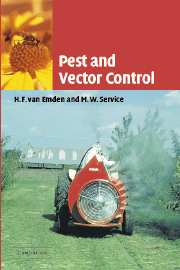Book contents
- Frontmatter
- Contents
- Preface
- 1 Man and insects
- 2 The causes of pest and vectored disease outbreaks
- 3 Insecticides and their formulation
- 4 Application of insecticides
- 5 Problems with insecticides
- 6 Environmental/cultural control
- 7 Biological control
- 8 Insect pathogens
- 9 Genetic control
- 10 Pheromones
- 11 Plant and host resistance
- 12 Other control measures and related topics
- 13 Pest and vector management
- Appendix of names of some chemicals and microbials used as pesticides
- References
- Index
10 - Pheromones
Published online by Cambridge University Press: 03 December 2009
- Frontmatter
- Contents
- Preface
- 1 Man and insects
- 2 The causes of pest and vectored disease outbreaks
- 3 Insecticides and their formulation
- 4 Application of insecticides
- 5 Problems with insecticides
- 6 Environmental/cultural control
- 7 Biological control
- 8 Insect pathogens
- 9 Genetic control
- 10 Pheromones
- 11 Plant and host resistance
- 12 Other control measures and related topics
- 13 Pest and vector management
- Appendix of names of some chemicals and microbials used as pesticides
- References
- Index
Summary
Introduction
It is becoming increasingly apparent that many behavioural activities of insects (e.g. dispersal/migration, mating, aggregation, alarm signalling and even fecundity) are under control via chemical messengers produced by individuals and liberated into the environment either as volatiles or in faeces, regurgitated food, etc. and perceived by the recipient either olfactorily or on contact. Also, chemical signals from different species, including ones from different biological Kingdoms (e.g. plants), can control insect behaviour. Those chemicals which pass messages between individuals of the same species have been given the general blanket term of ‘pheromones’ (see Birch and Haynes, 1982 for a good basic account) and are available to man for manipulating insect behaviour either by the use of caged insects, extracts from insects or plants or synthetic production (of the actual pheromone or a chemical ‘mimic’ thereof). Like all within- and between-species chemical signals, pheromones have particular advantages for pest control because they are usually highly species-specific, leave no undesirable residues in the environment and are effective in very minute quantities.
The umbrella term ‘ecomone’ was coined in 1977 to encompass all these communication signals, and pheromones – one type of ‘ecomone’ – are the subject of this chapter. The term semiochemical is also commonly used for any behaviour-modifying chemicals involved in communication between organisms, and has recently virtually replaced the term ‘ecomone’. Ecomones/semiochemicals other than pheromones (allomones, kairomones and synomones) are signals between different species where respectively the transmitter benefits (e.g. predator-repellent odours), the receiver benefits (e.g. signals from prey perceived by natural enemies) or both benefit (e.g. natural enemies responding to the odour of a pest-damaged plant).
- Type
- Chapter
- Information
- Pest and Vector Control , pp. 204 - 214Publisher: Cambridge University PressPrint publication year: 2004



